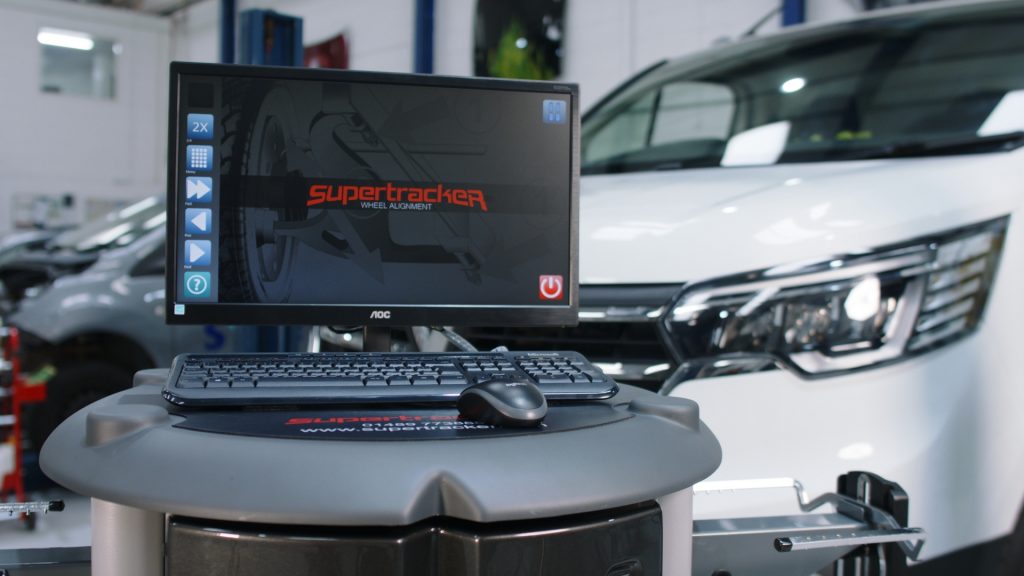A solid understanding of core alignment angles is essential for efficient diagnosis, precise adjustments, and delivering a high standard of service. While advanced systems can assist in identifying alignment issues, a good grasp of alignment angles enables technicians to interpret diagnostic results more effectively, resulting in quicker adjustments and safer, longer-lasting vehicle performance.
Mastering the angles enhances a technician’s ability to diagnose tyre wear, vehicle handling issues, and even fuel inefficiencies that result from misalignment. From thrust angle to caster, each alignment angle provides insights that can streamline diagnosis and improve customer satisfaction. With a good understanding of these alignment angles, even basic systems can be used to deliver accurate, high-quality results.
Thrust Angle: The Foundation for Alignment Accuracy
The thrust angle represents the direction the rear wheels point in relation to the vehicle’s centreline. When properly aligned, the thrust angle should match the vehicle’s centreline, allowing the car to drive straight. Misalignment here can quickly reveal itself in issues like:
- Tyre wear on one side: Uneven thrust angles can lead to irregular wear, making tyre replacements more frequent.
- Vehicle pulling: A misaligned thrust angle often causes a noticeable pull to one side, impacting steering ease.
Adjusting the thrust angle first ensures a stable baseline for other adjustments. An incorrect thrust angle can result in the steering wheel being off centre when front toe is adjusted.
Toe: Essential for Tyre Wear and Fuel Efficiency
The toe angle is a key factor in preventing feathering across the tread, poor handling and preserving fuel efficiency. Toe alignment determines whether the wheels point inward (toe-in) or outward (toe-out) relative to the centreline when viewed from above.
- Toe-In:
The wheels are pointing towards the centre line of the vehicle. Sometimes referred to as positive toe. - Toe-Out:
The wheels are pointing away from the centre line of the vehicle. Sometimes referred to as negative toe. - Total toe:
Refers to the combined angle of both front or rear wheels relative to the vehicle’s centre line. It is essentially the sum of the toe angles of the two wheels on an axle. - Partial toe:
Refers to the toe angle of an individual wheel on an axle, as opposed to the total toe.
Technicians who grasp toe principles can quickly address customer complaints about unusual tread patterns or handleability issues, often spotting and correcting these before they become expensive repairs.
Caster: Improving Stability and Steering Response
Caster angle, the tilt of the steering axis when viewed from the side, plays a vital role in steering stability. It is the angle between the vertical line and the steering axis (the line that runs through the upper and lower ball joints or strut mount and ball joint in the front suspension).
A positive caster angle tilts the steering axis rearward, while a negative caster tilts it forward.
While some vehicles do not allow for caster adjustment, technicians knowledgeable about caster can recognise its effect on vehicle behaviour and communicate this effectively to customers.
Camber Angle: Maximising Tyre Contact and Cornering Grip
The camber angle refers to the inward or outward tilt of the wheels when viewed from the front. Proper camber alignment optimises tyre contact with the road, ensuring even grip and reducing the risk of uneven tyre wear. Types of Camber Angle:
- Positive Camber: The top of the wheel leans outward (away from the vehicle).
- Negative Camber: The top of the wheel leans inward (toward the vehicle).
Incorrect camber tilts the tyre from vertical, reducing the contact between the tyre and the road even in a straight line. Incorrect camber can cause smooth wear on the edges of tyres, reduce cornering grip, excessive bearing wear and poor handling.
Setback: Diagnosing Structural Issues Early
Setback refers to the forward or rearward position difference between the front wheels. While a slight setback is often within manufacturing tolerances, significant setback might suggest structural issues. Detecting setback issues early through alignment checks can help technicians alert customers to potential frame issues before they become safety risks, establishing trust and avoiding future problems for the customer.
- Small setback (within factory tolerances) is normal, often due to slight differences in suspension or steering components.
- Excessive setback could potentially indicate issues like frame damage or bent suspension parts.

Understanding alignment angles directly translates into better service outcomes, without this knowledge, technicians risk making improper adjustments that can compromise safety, increase wear, and reduce customer satisfaction. With the correct knowledge, technicians can diagnose wear patterns, pulling issues, and other alignment-related concerns without solely relying on diagnostic equipment.
Visit Supertracker’s Wheel Alignment Studio in Worksop to see their equipment in action, or reach out for quotes and trade-in options. For inquiries or to schedule a demonstration, visit www.supertracker.com or contact us at info@supertracker.com.




You must be logged in to post a comment.